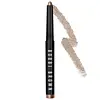What's inside
What's inside
 Key Ingredients
Key Ingredients

 Benefits
Benefits

 Concerns
Concerns

 Ingredients Side-by-side
Ingredients Side-by-side

Methyl Trimethicone
Skin ConditioningTrimethylsiloxysilicate
EmollientSynthetic Wax
AbrasiveLauroyl Lysine
Skin ConditioningPolymethylsilsesquioxane
Stearoxymethicone/Dimethicone Copolymer
EmollientOctyldodecanol
EmollientSilica
AbrasiveSynthetic Fluorphlogopite
Caprylic/Capric Triglyceride
MaskingPolyglyceryl-3 Polyricinoleate
EmulsifyingCopernicia Cerifera Wax
Polyhydroxystearic Acid
EmulsifyingPolyethylene
AbrasiveMicrocrystalline Wax
Emulsion StabilisingIsostearic Acid
CleansingDicalcium Phosphate
AbrasiveLecithin
EmollientDisteardimonium Hectorite
StabilisingPropylene Carbonate
SolventCalcium Aluminum Borosilicate
Calcium Sodium Borosilicate
Tin Oxide
AbrasivePentaerythrityl Tetra-Di-T-Butyl Hydroxyhydrocinnamate
AntioxidantMica
Cosmetic ColorantCI 77891
Cosmetic ColorantCI 77491
Cosmetic ColorantCI 77492
Cosmetic ColorantCI 77499
Cosmetic ColorantCI 77007
Cosmetic ColorantCI 42090
Cosmetic ColorantCI 77288
Cosmetic ColorantCI 77289
Cosmetic ColorantCI 19140
Cosmetic ColorantCI 77510
Cosmetic ColorantCI 75470
Cosmetic ColorantCI 77400
Cosmetic ColorantCI 77163
Cosmetic ColorantCI 77000
Cosmetic ColorantCI 77742
Cosmetic ColorantMethyl Trimethicone, Trimethylsiloxysilicate, Synthetic Wax, Lauroyl Lysine, Polymethylsilsesquioxane, Stearoxymethicone/Dimethicone Copolymer, Octyldodecanol, Silica, Synthetic Fluorphlogopite, Caprylic/Capric Triglyceride, Polyglyceryl-3 Polyricinoleate, Copernicia Cerifera Wax, Polyhydroxystearic Acid, Polyethylene, Microcrystalline Wax, Isostearic Acid, Dicalcium Phosphate, Lecithin, Disteardimonium Hectorite, Propylene Carbonate, Calcium Aluminum Borosilicate, Calcium Sodium Borosilicate, Tin Oxide, Pentaerythrityl Tetra-Di-T-Butyl Hydroxyhydrocinnamate, Mica, CI 77891, CI 77491, CI 77492, CI 77499, CI 77007, CI 42090, CI 77288, CI 77289, CI 19140, CI 77510, CI 75470, CI 77400, CI 77163, CI 77000, CI 77742
Dimethicone
EmollientPolymethylsilsesquioxane
Polyethylene
AbrasiveSucrose Tetrastearate Triacetate
EmollientPolyisobutene
Trimethylsiloxysilicate
EmollientSilica
AbrasiveCoco-Caprylate/Caprate
EmollientHydrogenated Castor Oil
EmollientTrimethylpentanediol/Adipic Acid/Glycerin Crosspolymer
Skin ConditioningSilica Silylate
EmollientMethicone
EmollientGlyceryl Caprylate
EmollientPentaerythrityl Tetra-Di-T-Butyl Hydroxyhydrocinnamate
AntioxidantTriethoxycaprylylsilane
Stearalkonium Hectorite
Gel FormingCI 77491
Cosmetic ColorantCI 77492
Cosmetic ColorantCI 77499
Cosmetic ColorantDimethicone, Polymethylsilsesquioxane, Polyethylene, Sucrose Tetrastearate Triacetate, Polyisobutene, Trimethylsiloxysilicate, Silica, Coco-Caprylate/Caprate, Hydrogenated Castor Oil, Trimethylpentanediol/Adipic Acid/Glycerin Crosspolymer, Silica Silylate, Methicone, Glyceryl Caprylate, Pentaerythrityl Tetra-Di-T-Butyl Hydroxyhydrocinnamate, Triethoxycaprylylsilane, Stearalkonium Hectorite, CI 77491, CI 77492, CI 77499
 Reviews
Reviews

Ingredients Explained
These ingredients are found in both products.
Ingredients higher up in an ingredient list are typically present in a larger amount.
Ci 77491 is also hydrated iron III oxide. It's sole purpose is to give a red/pink hue to products.
Iron III oxides are classified as inorganic chemicals for coloring.
Synthetically created Ci 77491 is considered safer than those naturally found. This is because the synthetically created version may contain less impurities. Iron oxides are generally non-toxic and non-allergenic.
Learn more about CI 77491Ci 77492 is also hydrated iron III oxide. It's sole purpose is to give a yellow hue to products.
Iron III oxides are classified as inorganic chemicals for coloring.
Synthetically created Ci 77492 is considered safer than those naturally found. This is because the synthetically created version may contain less impurities. Iron oxides are generally non-toxic and non-allergenic.
Learn more about CI 77492Ci 77499 is also hydrated iron III oxide. It is created from mixing red and black iron oxides. This helps give shades of darkness to a product.
Iron III oxides are classified as inorganic chemicals for coloring.
Pentaerythrityl Tetra-Di-T-Butyl Hydroxyhydrocinnamate (long name, huh?) is a synthetic antioxidant.
It is used to help stabilize other antioxidants or prevent the color from changing in a product.
As an antioxidant, it helps fight free-radical molecules. Free-radical molecules are capable of damaging our cells and other genetic material. Thus, antioxidants may reduce the signs of aging.
This ingredient is oil-soluble.
Learn more about Pentaerythrityl Tetra-Di-T-Butyl HydroxyhydrocinnamatePolyethylene is a synthetic ingredient that helps the skin retain moisture. It is a polymer.
It is also typically used within product formulations to help bind solid ingredients together and thicken oil-based ingredients. When added to balms and emulsions, it helps increase the melting point temperature.
Polymethylsilsesquioxane is a silicone used as a film forming agent.
When applied to the skin, this ingredient creates an invisible film on the surface. This film still allows oxygen to pass through, but prevents moisture from escaping. This can help condition and hydrate the skin. It also leaves a silky feel when applied.
Polymethylsilsesquioxane has not been shown to clog pores. It has been deemed safe to use up to 55%, but most cosmetics use much less.
If you have concerns about using this ingredient, we recommend speaking with a professional.
Learn more about PolymethylsilsesquioxaneSilica, also known as silicon dioxide, is a naturally occurring mineral. It is used as a fine, spherical, and porous powder in cosmetics.
Though it has exfoliant properties, the function of silica varies depending on the product.
The unique structure of silica enhances the spreadability and adds smoothness, making it a great texture enhancer.
It is also used as an active carrier, emulsifier, and mattifier due to its ability to absorb excess oil.
In some products, tiny microneedles called spicules are made from silica or hydrolyzed sponge. When you rub them in, they lightly polish away dead skin layers and enhance the penetration of active ingredients.
Learn more about SilicaThis silicone is an emollient. Emollients create a thin film on the skin to prevent moisture from escaping.
It is not soluble in water and helps increase water-resistance in products.
According to a manufacturer, it can blend seamlessly with silicone oils, such as Cyclopentasiloxane.
Learn more about Trimethylsiloxysilicate